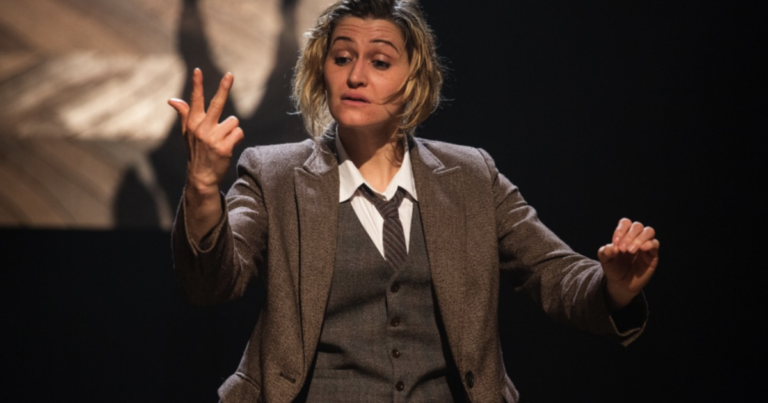On Sept. 16, Penn State students have the opportunity to see a demonstration of what is possible through Why Not Theatre’s bilingual production of Shakespeare’s “Prince Hamlet” hosted by the Center for the Performing Arts.
This production challenges the constructs of tradition and questions who can play these characters, according to Why Not Theatre’s website. The company not only includes performers of all backgrounds, but it is also gender bent.
“I was interested in the fact that they’re challenging who is at the center of storytelling,” Sita Frederick, director of CPA, said.
Usually, sign language interpreters stand at the side of the performance, and the people who need or want the interpreter are sitting at an angle to best view the interpreters, Frederick said.
But instead, there are no interpreters during this performance, and it’s narrated in American Sign Language by performer Dawn Jani Birley, who will play Horatio.
Miriam Fernandes is one of the co-artistic directors of the Toronto company who is also playing Rosencrantz, the Player King, the Gravedigger and Bernardo.
Fernandes said many hearing people “don’t really clock out how much the world is made for us.”
Fernandes, alongside director Ravi Jain, thought of doing “Hamlet” again, and they asked themselves, “How do we actually see this story differently?”
“We live in a world where everybody is not the same,” Fernandes said. “So, why can’t we reflect that on stage?”
After casting, collaborating and communicating, they decided to make the show an intersectional experience for both hearing and Deaf audiences.
“An inclusive show means that all hearing people are including Birley, and she is just the outsider,” Fernandes said. “Whereas an intersectional show means that it is actually meant for both these audiences.”
By doing this, the company demonstrates an equity experience where the audience has to engage in a different way than usual, according to Fernandes.
In an interview done with canadianstage, Birley said, “Nobody is a target,” and the show is not “being produced for another group.”
Through rehearsals, Fernandes said a lot of the cast members picked up ASL. In fact, many characters sign in the show, such as Hamlet, who is played by Eli Pauley.
According to Fernandes, it’s an intricate process to make sure everyone is on the same page and working cohesively.
“There are a million tiny physical and visual cues that are embedded into all of the blocking,” Fernandes said.
Since March 15, 2021, Frederick said she wants to use her role as director of CPA to not only give “people part of what they want” but also find ways “to have those conversations that could be a challenge.” Frederick said the arts offer “an unusual way to have those conversations.”
“Disability is not a deficit, it’s not an impairment,” Frederick said. “There are strengths that come with being deaf as opposed to lack. And the culture surrounding it is one of those strengths.”
These strengths make up what is known as Deaf gain.
According to Associate Teaching Professor Sommar Chilton, who teaches many ASL classes at Penn State, Deaf gain is the idea “that there are benefits of being a Deaf individual in our society and what they can contribute to our society.”
Chilton said “being deaf allows you to navigate this world in a different way, it’s not lacking in any way.”
In Chilton’s opinion, the phrase “hearing impairment” should be eliminated as it’s not an identifier for many people who ascribe to the Deaf community, and it was coined by people who do not identify as Deaf.
Extending people’s knowledge in ASL or just in the Deaf community and Deaf culture is extremely important, Chilton said.
“At some point, people are going to have a coworker who is deaf or a friend or neighbor or someone who is in their community,” Chilton said. “If they haven’t learned about this before, then they are going to make the same common mistakes.”
Fernandes and the company are hoping to engage their audience in a unique way.
“Hearing people come to Shakespeare for the beauty of the poetry and the musicality of the text and the imagery, and have all these beautiful experiences with their ears,” Fernandes said.
The company’s goal is for the audience to experience the show with their eyes with the intention that it’s “so beautiful that it’s like music to their eyes,” Fernandes said.
The show premieres at 7:30 p.m. on Sept. 16, followed by performances at 2 p.m. and 7:30 p.m. on Sept. 17 in the Playhouse Theatre.
Tickets for Penn State students are $5, adults are $35 and 18 and younger are $18.
Frederick said she hopes “people [will have] a magical evening of transformative theatre” and “have a change in their heart and mind about what’s possible.”
MORE LIFESTYLE COVERAGE
It’s time for our annual pizza review, and although it’s cheesy, it’s still crucial to the P…



